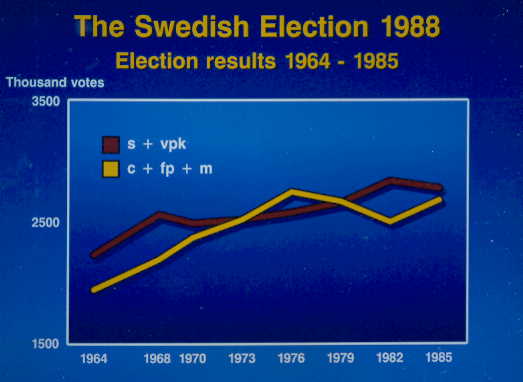
Speech delivered at the Swedish Chamber of Commerce for the United Kingdom, London, January 28, 1988.
The
interest on part of the international community in Swedish politics is
modest. Politically we are a dull
country, normally ruled by Social Democrats and/or Social Democratic ideas. The Social Democratic Labour
Party is a nearly 100-year-old party that has spun a tight network of public
services and auxiliary voluntary associations and unions into every corner of
the Swedish scene. In the past 56 years
the country has been ruled by Social Democrats during 50 years and by Social
Democratic ideas executed by non-socialist for six years.
Most
Swedes have been reasonably happy with this state of affairs. By carrying the country through the
depression of the 1930s, through World War II without getting involved in the
fighting, and through the post war boom, the ruling Social Democracy gained
considerable legitimacy. 44 years of holding the premiership, 1932 to 1976, is
a very long time in politics. It began
before Hitler and it ended after Mao. No wonder that for the Swedes --
including the opposition -- Social Democracy defines the terms and images of
politics. Every Swede is a little bit
of a Social Democrat, whether he or she likes it or not.
0O0
Olof Palme, the most well known and the most
controversial of the Social Democratic Premiers, was assassinated on February
28, 1986. He had attended a movie with
his family. He had brought no security
guards, nor any chauffeur-driven limousine. He was walking to the Stockholm metro to take the subway train back home
- three stops down the line. Like most Swedes, he lived an unassuming life,
void of ostentation, in this open, innocent and calm society (yes, you may say
it is dull).
The Swedes lacked both the psychological and
administrative preparedness for such an event. The assassination of a head of government was something they associated
with other parts of the world, not with Europe, and least of all with
Scandinavia. The police work was
scandalously poor and the assasin got away.
The site of the assassination at the corner of
Tunnelgatan and Sveavägen, one of Stockholm's main streets, quickly became a
place of pilgrimage, almost a shrine, to which people brought poems and roses.
The funeral of Olof Palme was not a state funeral in a
cathedral with officiating bishops and a coffin carried by generals. It was a party funeral that took place in
the Town Hall of Stockholm. The
pre-eminent symbols were the emblem of The United Nations, the plain white
coffin blanketed with red roses, and the hundreds of black-shrouded scarlet
banners of Sweden's workers' districts. The Social Democratic Party saw nothing wrong in this: it has dominated
Swedish politics for half a century and makes little distinction between itself
and the state.
The funeral was attended by heads of state and
dignitaries from all corners of the globe. They were seated in alphabetical,
not diplomatic order.
The funeral
represented a majestic tribute from supporters, opponents, and colleagues from
all over the world to the basic common denominator of values we share and to a
consensus about what constitutes a praiseworthy politician in our times. The Secretary of The United Nations
described Palme as "the quintessence of democratic man."
The
assassination of Olof Palme is the most important political event in the life
of the present parliament. The Social
Democratic Labour Party emerged revitalized from the crisis following the
assassination of Olof Palme. The party
surged ahead in the polls, and its new leader Ingvar Carlsson received a
confidence rating from the Swedish public that far surpassed any rating ever
received by the controversial Olof Palme.
oOo
There is no strong
spirit of opposition at hand in Sweden. Now and then, the ruling Social Democrats are accused of showing the
arrogance of power. For one thing, like
all (foolish) entrenched ruling parties, they use their power of appointment to
give most every leading post in the country to a party faithful. At present, however, unemployment is very
low, inflation is modest, the budget deficit is down. The mood of the land is that the Social Democrats will continue
to rule, and may even deserve to do so.
However, since 1964, there has emerged something like a British political rhythm: swings between the party of the left and the party of the right. (I am, of course, aware that Mrs. Thatcher has broken the normal rhythm by being re-elected a third time; such exceptions, however, do not cancel the main pattern of British political history.) In Sweden, a constitutional reform in 1970 abolished the upper house of Parliament and allowed such swings their full political consequences.

The socialist parties
in Sweden lost their majority i 1973 but continued to rule with a hung
parliament in which deadlocked issues were decided by the drawing of lots. In 1976, the non-socialists gained the
government for six years, that is, two election periods. In 1982 the socialists were back in power,
and they kept it with a reduced majority in 1985. Now, in the September election of 1988 we will find out whether
politics in Sweden is to remain a one-party affair like politics in Mexico or
Japan, or, to become a politics of alternating governments like Britain and the
Continent.
oOo
Political scientists
need not consider Swedish politics as dull. They can find their research stimulated by the fact that the Swedish
elections in the 1980s (along with the Danish) are the first ones in Western
Europe in which an absolute majority of the franchised derive their livelihood
from public funds. Sweden offers a
first-rate opportunity to study what happens when a country attempts to combine
the majority rule of democracy with such a large-scale public welfare so that a
majority is supported, in one way or another, by tax money.
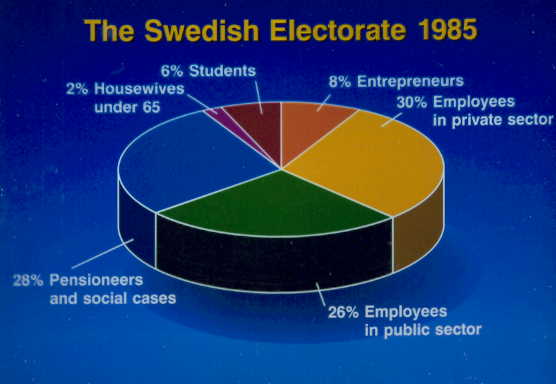
An absolute majority
of the 6.4 million enfranchised in the
Swedish elections of
the 1980s consists of those who are employed in the public sector or have their
primary source of income from the public coffers because of their entitlements
as pensioners, unemployed, chronically disabled, et cetera. Together, the "publicly supported"
constituted 52 percent of the voters in 1982, 54
percent in 1985 and 55 percent 1988 of the electorate.
Quite in line with these numbers is the Swedish tax
bite. Taxes constituted 51 per cent of GNP in 1982, 52 per cent in 1985 and 56
per cent in 1988. Needless to say, these rates are repeated world records of
taxation.
There, for the grace of God and Mrs. Thatcher goes
Britain, you may say.
The fathers of democracy never pondered such a
situation. The very thought that the
public sector would grow so large was beyond the horizons of their imagination.
Their reasoning was based
on the premise that the state with all its powers is in the hands of a minority
who are also living off the state. The
problem addressed by the fathers of democracy concerned the control this
minority. They devised democracy to
ensure that the ruling minority followed the will of the majority, who
naturally gained their livelihood in the private sector.
Sweden's problem has become the reverse: how shall a
minority who derive their incomes from the private sector protect themselves
against a publicly supported political bloc which not only represents a
majority of the electorate but can also draw upon all the sources of power
available to the state? And how is the
publicly supported plurality to guard against making decisions by majority rule
granting themselves favours that ruin the country?
In the early 1930s
the Social Democrats began the long process of casting the powers of the state
in the role of ally rather than adversary. Implementation of welfare was placed in public aegis, both the financing
and the administration.
The Social Democrats favoured public sector expansion
and they turned in due course the swelling ranks of the public employees into
their voting support. The old bourgeois civil service became a minority in most of the bureaucracies.
When those dependent
on public funds for their livelihood were in a minority, the Social Democrats
had great appeal with the promise that they would enlarge the welfare
system. This proved most effective and
resulted in the 44-year rule 1932 to 1976.
The 1982 election was
the first one in which the publicly supported constituted more than 50 per cent
of the electorate. Now, when those
supported by public funds are in a majority, the Social Democrats' appeal lies in
their promise to preserve the welfare system as it stands. This sufficed in 1982 to secure a working
majority in the Riksdag without any promises of new welfare reforms. In the 1985 election the power gained on
this basis was consolidated.
To the public at
large the party has portrayed itself as the defender of the rights of all
citizens to tax-financed benefits and services. Internally, to those employed
in the public sector or dependent upon it for their income, the Social
Democrats portray themselves as the party that will guarantee their jobs and
benefits.
This Janus face gives
the Social Democrats a mighty position in the public debate. On the one hand they have almost free rein
to tend to the selfish interests of the many employees and workplaces in the
public sector. At the same time they
can claim to be the party that cares for the well-being of the entire citizenry.
oOo
What is the party
structure that sustains this kind of politics?
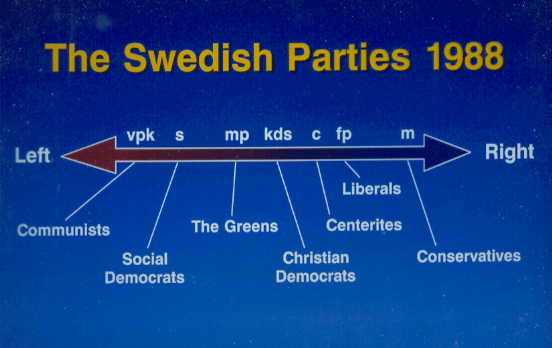
At stake in a Swedish
election - the next one is in September this year - is the manning of a truly
Big Government, albeit in a small state. The winners will directly control two
thirds of the GNP, and indirectly much of the remaining economy. The
incumbents, the Social Democratic Party
are designated (s). They are in the
main supported by Sweden's small Communist party (vpk).
The opposition
represents established bourgeois interests revitalized in the 1980s by the
Swedish counterpart to Thatcherite ideas, that is, neoliberal economic ideas of
our times and the revived moralism that calls for personal, family and network
responsibility rather than public welfare institutions. The opposition is split into four loosely
aligned parties: the Conservatives (m), the Liberals (fp), and the former Agrarians
called the Centerites (c), and the small Christian Democrats (kds).
The Constitution
excludes minor parties receiving less than 4 percent of the popular vote from
the Riksdag. By using a joint ticket
with a major party -- which is not unconstitutional in a technical sense -- a
minor party such as the Christian Democrats, got a seat in the 1985 Parliament
anyway. Such deals will not be repeated in 1988.
In the battle is also
an ecological party, the Greens (mp), which is expected to make progress this year,
and, according to the polls, for the first time gain seats in Parliament.
oOo
The simple scale of
the parties from left to right is a misleading guide to Swedish politics. In the Swedish multi-party system, the
parties' fight for votes is a war waged on all fronts. For a Liberal the struggle against the
Conservatives can be as important as that against the Social Democrats. For a Social Democrat the battle against the
Communists may seem as urgent as that against the Center Party. There are, however, three main frontlines in
the political battlefield of the 80s, and the parties may from time to time
variously join forces along these lines. The three fronts are the labour market, the commodity market, and
growth. The way the parties group themselves along
these fronts is illustrated in our diagram.
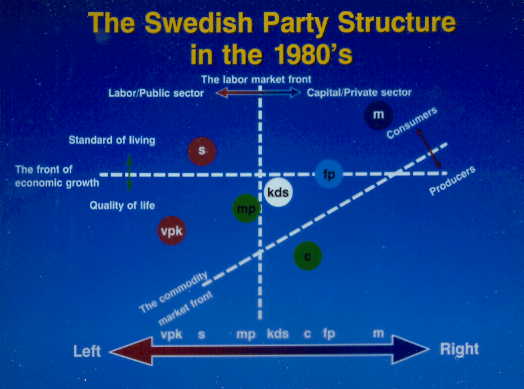
Most clashes occur
along the frontlines of the labour market. The struggle is for power over work
and the workforce, the production apparatus, and its surplus profits. The
frontline coincides with the preference for the private sector and the public
sector. The forces are aligned as follows:
Conservatives + Liberals + Centerites
against Social Democrats + Communists
This
frontline is the basis for the blocs in Swedish politics - the non-socialists
and the socialists, those who favour individual/entrepreneurial solutions and
those who favour collective/egalitarian solutions.
The other
front is the commodity market, primarily foodstuffs. The producers of
foodstuffs are in conflict with consumers. At the heart of the conflict are the
requisites conditions for primary industry and sparsely populated rural areas,
subsides to agriculture, and foodprices. The forces are aligned thusly:
Centerites
against Social Democrats + Communists + Liberals +
Conservatives
This front
is loosing importance; there are only 90.000 active farmers in the country. The
front is being redefined as periphery against the centre.
In
Swedish, Norwegian and Finnish history the farmers have never been serfs in a
feudal system. Thus we early had the
prerequisite for agrarian parties who organized the farmers while other parties
organized people in commerce and industry. The presence of the agrarian parties has split the bourgeois political
front in the Nordic countries and created the "Nordic decease of
politics": inability to oppose Social Democracy in a united way. The agrarian parties have often been ready
to enter compromises with the socialists, or enter coalition governments with
them. Only when the Swedish Centerites
in 1976 turned against the nuclear energy policy of the Social Democrats could
the latter be defeated.
The third
frontline is growth. The fight is between supporters of economic growth and
quality of life. It concerns the environment, large-scale industry, elaborate
bureaucracy, and heavy dependence on exports, decentralization. The forces are
aligned thusly:
Centerites
+ Communists + Greens against Liberals
+ Social Democrats + Conservatives
We
recognize this front from the 1980 referendum on nuclear energy. There are
indications of other minor frontlines. One would be the religious front, where KDS, the Christian Democratic
Socialists, stand-alone against all other parties, with the possible exception
of the Centre Party. Yet another would
be foreign affairs: APK, the Workers' Communist Party, is Stalinist and loyal
to the Soviet Union through thick and thin, and stands in opposition to all
other parties, particularly the Conservatives are viewed as more friendly to
the United States than others. In
contrast to many other countries, Swedish party structure does not evince any
marked alignment along cultural-ethic lines.
The
Green party is quality-of-life oriented, is more non-socialist than socialist,
and differs from the Centre party in that it is more concerned with the
consumer than with the producer.
oOo
The regional election
trends show the Conservatives and Liberals jointly dominating the three
metropolitan regions of the country. In
the Stockholm, Gothenburg and Malmoe area they are bigger than the Social
Democrats. Centerites and Communists in
these areas are environmental parties, as are the Greens.
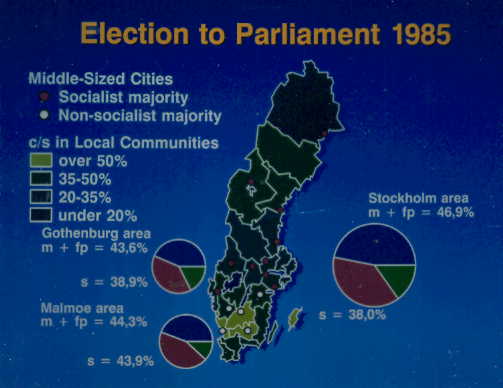
In the middle-sized
cities in the southern third of the country the non-socialists rule. (The
pattern is similar to England south of Manchester.) In the northern cities the
socialists rule.
In the
periphery, or country side, the battle rages between Centerites and Social
Democrats. The Centerites are strong in two bands across the country, from
Halland to Gotland in the south, and in Jämtland in the north.
oOo
It so happens that
all parties in parliament except the Communists have new leaders. The Liberals
shifted to Bengt Westerberg prior to the last election, the others go into the
campaign with entirely new leaders. All parties have chosen experts as leaders.
Gone are the great gamesmen such as Palme (s) and Adelsohn (m) and Fälldin (c),
the helper
and facilitator Karin Söder (c). In came the knowledgeable men from middle
management and staff, men with facts and statistics but without classical
education, global experience, or practical knowledge that can only be gained
from the leadership of large, complex organizations.
Public
confidence in these men varies.
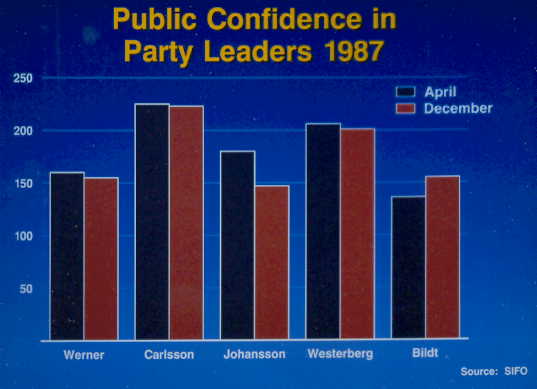
By a large
margin, the Social Democratic and the Liberal leader are in top.
oOo
The size and
pervasiveness of the body politic in Swedish society make for many political
issues and is in itself an issue in the political debate.
The issues of the 1988 election are
illustrated in this chart.
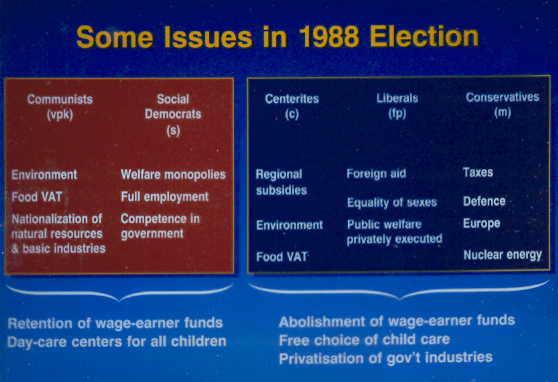
Free
choice of subsidized child care is one of the issues that joins the three
non-socialist parties in this election. It is the first time that the
non-socialists have a popular welfare issue and the Social Democrats stand for
an unpopular issue.
oOo
To what does this all
add up? I have asked my computer.
If the 1988 election
runs a normal course without unforeseen upsets, our calculations indicate that
the non-socialist bloc will resume the pattern it evinced between 1964 and 1976
prior to the disappointments with the Fälldin governments of growing at a
faster rate than the socialist bloc. The period 1982-85 began this tack. This would make for a close election, not
uncommon in Sweden. The odds, as I
calculate them at this early stage, are, however, in favour of the non-socialists, but with the
prospect that the
Greens will hold the balance of power in Parliament.
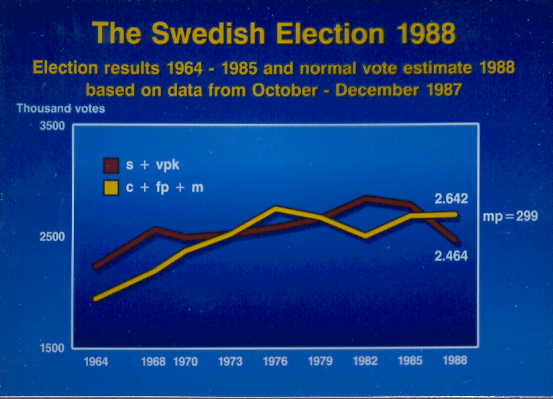
Green
parties tend to use parliaments as stages for political theatre rather than
political compromise. Thus I predict a weak
and unstable government in Sweden after this fall's election. We get a shift in government, a normal
European swing between left and right, but at the price of instability and
political inexperience.
That is
the end of my tale. Thank you very much!